
by Megan Dayton (Senior Demographer for Minnesota’s State Demographic Center in the Department of Administration)
March 2024
Migration is not just a number or a trend—it is a dynamic force influencing Minnesota's economic and social fabric. Understanding the patterns of who comes in, who leaves, and why can provide critical insights for more robust policy planning and resource allocation. Migration has real-world implications that affect everything from the state's labor market to its demographic composition, from housing demand to the business environment. Essentially, people's choices to move into or out of Minnesota set off a chain reaction of economic and social changes vital for understanding the state's future shape.
When people move to Minnesota, they bring a range of attributes—skills, labor potential, and a demand for various services and goods. This influx results in immediate and longer-term economic activities, including a rising demand for housing, increased consumer spending, and the introduction of new talents and skills into the local labor market. Conversely, when people leave, they create gaps in the state's economic and social fabric. These gaps can manifest as job vacancies, reduced demand for local businesses, or changes in the demographic makeup, each of which has unique economic repercussions.
From 2001 to 2022, data from the Census Bureau's Population Estimates Program (PEP) indicates that Minnesota experienced a net migration gain, with more people moving into the state than leaving it. This trend was particularly pronounced between 2011 and 2019, during which Minnesota welcomed a net increase of 92,000 individuals. Various factors likely contributed to this influx, including favorable state and regional economic conditions, policies designed to encourage migration, and broader regional influences. International factors, such as global economic trends and international relations, could also have shaped Minnesota's appeal as a destination.
However, it is noteworthy that 2020, 2021, and 2022 diverged from this trend, showing net outflows of 1,400, 10,800, and 5,200 individuals, respectively. More immediate circumstances, such as the COVID-19 pandemic and changes in federal immigration policy, are likely influencing these recent shifts. However, the recent decline in net migration warrants close attention. While specific, immediate factors like the COVID-19 pandemic could be the culprit, it is also possible that these numbers mark the beginning of a new trend. As such, it is essential to interpret this dip within the larger context of Minnesota's migration history while remaining open to the possibility that it could signal a shift in the state's long-term migration dynamics. Balancing these two perspectives will help us better understand whether the recent changes are an anomaly driven by exceptional circumstances or the onset of a new migratory pattern for Minnesota.
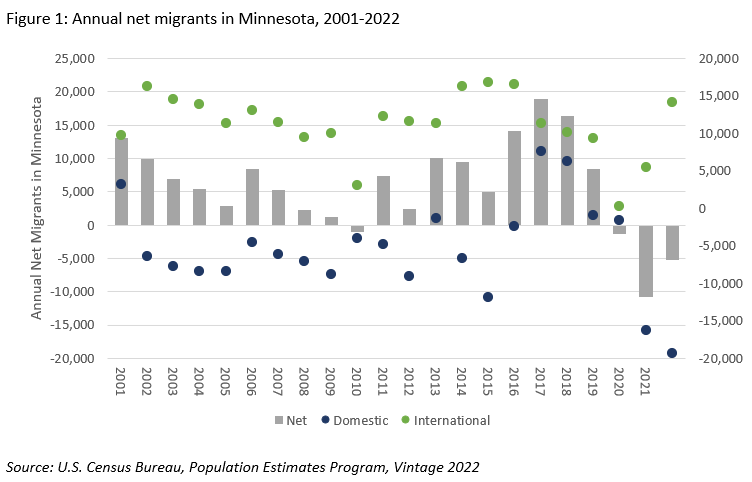
Minnesota's migration patterns over the past two decades present a complex picture that diverges from broader national trends in some respects. While the United States has seen consistent positive net international migration, individual states, including Minnesota, have displayed varying results in domestic migration. Specifically, Minnesota has often experienced net negative domestic migration, although its international migration remained positive for most of the period under review. This dichotomy suggests that while the state shares the United States' broader appeal as a destination for international migrants, it faces distinct challenges and dynamics when retaining or attracting residents domestically. These nuances in Minnesota's migration trends contribute to its unique economic and social landscape, distinguishing it from the general migratory patterns seen at the national level.
Migration plays a pivotal role in shaping the many dimensions of a region, including its economy, culture, and social dynamics. Minnesota serves as a compelling case study in this regard, attracting a multifaceted mix of individuals both from within the United States and globally. Scrutinizing data from the Census Bureau's American Community Survey (ACS) microdata over two decades (2001 to 2021) gives us more details about the characteristics of people coming to and going from Minnesota. During this period, 81% percent of those who migrated to Minnesota came from other U.S. states. This figure is striking, primarily because public discourse often focuses on international migration or the narrative of people leaving the state, overshadowing this significant domestic inflow. However, it's crucial to interpret this statistic within a broader context. Factors such as geographical proximity to other states, federal regulations, and law enforcement practices could also shape these domestic migration patterns. Therefore, while the data may suggest that Minnesota offers a quality of life or opportunities that attract domestic migrants, it's essential to consider these other contributing variables.
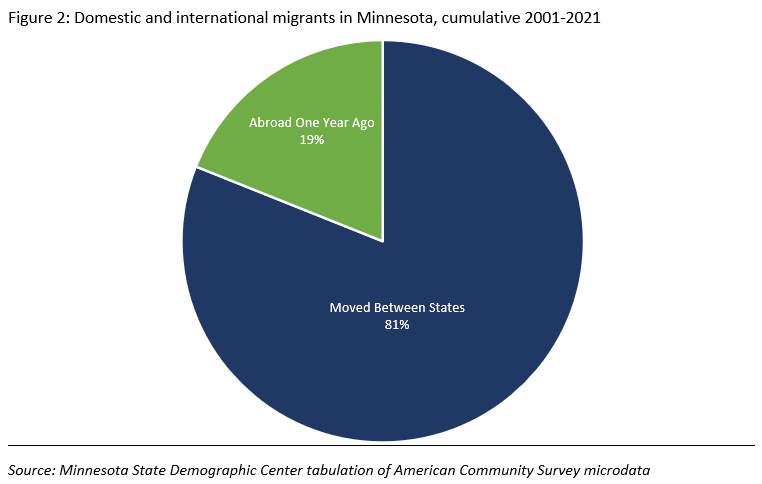
On the international front, 19% of migrants coming to Minnesota arrived from countries outside the United States. Though smaller in proportion compared to domestic migrants, this group has the potential to influence Minnesota's cultural and social landscape significantly. It includes a diverse mix of refugees, high-skilled workers, and international college students (among others), each bringing unique skills, experiences, and worldviews to the state. These varying pools of international migrants enrich Minnesota's cultural fabric and contribute significantly to its global profile.
The data on migration patterns holds implications for Minnesota and offers an opportunity for comparative analysis with neighboring states. Minnesota's high rate of domestic in-migration, relative to international in-migration, calls for comprehensive state policies that address various issues from workforce development to housing and social services.
Minnesota's migration patterns exhibit distinctive features when juxtaposed with other regional states. For example, Wisconsin, North Dakota, and Iowa generally display higher percentages of domestic in-migration—87, 91, and 87 percent, respectively—paired with lower rates of international in-migration at 13, 9, and 13 percent. In contrast, states with major metropolitan areas like Illinois and Michigan show a migration mix more akin to Minnesota's, with 76% domestic and 24% international. This balance suggests that states with large urban centers are often more successful in attracting a diverse array of international migrants.
Analyzing migration to Minnesota necessitates a nuanced understanding beyond the dichotomous domestic and international categories. While these labels provide an initial analytical framework, they can often obscure migratory patterns' complex, multifaceted nature. Thirteen percent of those who moved to Minnesota from another state were foreign-born. Furthermore, 40% of international migrants were U.S. citizens; notably, 25% of this subgroup were born in Minnesota. These numbers offer a more intricate view, challenging simplified categorizations. They show that domestic migration includes a significant proportion of individuals born outside the U.S. In contrast, international migration may comprise individuals who are U.S. citizens and native Minnesotans.
Given these intricacies, it becomes essential to interpret these statistics as elements of a diverse and complex demographic landscape. Minnesota's migration profile is distinct, especially when considered within a regional context, and comprises a rich blend of domestic and international influences. This complexity enriches our understanding of the state's evolving social and economic fabric, providing crucial insights for future academic exploration and discussion.
Various factors influence domestic migration, such as job opportunities, personal goals, quality of life, and family connections. Data from the last ten years shows that people moving to Minnesota often come from the same U.S. states. Data from the Current Population Survey (2010-2022) reveal insights into exploring the motivations behind domestic migration into Minnesota. Notably, nearly 40% of recent domestic migrants cite the desire for new, better, or their own housing as the primary reason for moving to the state. This finding underscores the centrality of housing considerations in individuals' migration decisions and suggests that the public may perceive Minnesota's housing options as attractive or advantageous. Therefore, the state's evolving domestic migration profile aligns with individual aspirations for improved living conditions.
The interconnectedness between Minnesota and Wisconsin is striking, symbolizing the tightly woven socio-economic and cultural relationships that often exist between neighboring states. Given the states' proximity, sometimes as close as crossing a river, the fluidity in migration between the two is significant. According to the ACS, between 2001 and 2010, Wisconsin provided a substantial inflow of roughly 195,000 individuals to Minnesota while reciprocally absorbing over 212,000 Minnesotans. This bidirectional movement accentuates these neighboring states' intricate ties and mutual dependencies. North Dakota also plays a significant role in Minnesota's domestic migration landscape, with around 93,000 North Dakotans moving to Minnesota and a larger counter-flow of approximately 156,000 Minnesotans relocating westward. These migratory currents highlight the shared economic and social factors driving mobility between the two states. Other states, such as Illinois and Iowa, are not to be overlooked in this migratory equation. Around 86,000 individuals from Illinois and 76,000 from Iowa have made their way to Minnesota, likely in search of the state's diverse opportunities and lifestyle offerings. Given these figures, it is essential to recognize that migration within this regional context can sometimes be as straightforward as a short journey across a river, reflecting not just the allure of opportunities but also the ease and convenience of mobility in the domestic landscape.
California, Arizona, and Florida are significant players in Minnesota's domestic migration patterns, but this is not necessarily surprising because larger states are naturally more likely to have higher levels of migration simply because they have more people. Around 72,000 people moved from California to Minnesota, and approximately 78,000 went in the opposite direction. Similarly, about 80,000 people each moved between Minnesota and sunbelt states like Arizona and Florida.
A closer look at the data for those aged 65 and older shows that these states are among the top destinations for older migrants from Minnesota. Arizona, Florida, Wisconsin, Texas, and California are the top five destinations for individuals aged 65 and over who lived in Minnesota one year ago. This trend could be due to various factors, but weather conditions, particularly in Arizona Florida, California, and Texas, likely make them attractive options for retirees. This migration pattern is not surprising, but it does offer insight into the decisions that older individuals make when choosing a state to move to. While the numbers may seem remarkable initially, they align well with migration theories that account for state population sizes and specific age group preferences.

International immigration is a complex interplay of individual choices and external circumstances, ranging from economic aspirations and academic quests to the lure of security or the pull of family ties. The diversity of motivations enriches when including refugees, who are typically assigned to their initial resettlement locations rather than choosing them. Their presence adds another layer of complexity and depth to the state's international community, contributing meaningfully to Minnesota's social fabric. While Minnesota's opportunities and community ethos may draw many migrants, refugees may find themselves in the state through resettlement programs, contributing to its social fabric in a manner less driven by individual choice but equally impactful. Therefore, as Minnesota continues to incorporate the stories of its international arrivals, both voluntary and involuntary, it shapes a future that is both globally connected and locally grounded, reflecting a diversity of experiences and backgrounds.
Over the last decade, Minnesota has become a popular destination for international migrants, each contributing unique elements of their own culture, enriching Minnesota's cultural diversity and strengthening its global economic connections. India has been a notable source of new residents, with about 33,000 individuals moving to Minnesota. China follows with around 21,000 migrants, contributing to the state's cultural richness and economic partnerships. Other significant sources of migrants include Mexico, Eastern Africa, and neighboring Canada. The influx of people from these regions enhances Minnesota's international appeal and underscores its role as a multicultural center.
While the data detailed who is moving into Minnesota, there are notable gaps in our understanding of the migration patterns of people leaving the state. Specifically, the data lacks comprehensive information on the destinations of departing Minnesotans globally. This gap is primarily due to limitations in data collection methods. This data is necessary to fully understand the motivations for out-migration and the demographic or economic factors influencing these decisions.
The mobility of young adults aged 18 to 24 is significant in Minnesota's migration patterns. Often on the cusp of considerable life decisions like pursuing higher education, entering vocational training, embarking on first jobs, or experiencing other transformative life events, this age group displays a heightened sense of mobility, significantly influencing Minnesota's socio-economic landscape. A recurring trend emerges when analyzing data from the past decade and a half: the 18 to 24 age group consistently represents a dominant fraction of both in-migrants and out-migrants. As of 2021, they made up 33% of individuals leaving Minnesota and 24% of those entering, more than any other age group. These numbers highlight the frequent movement of people, affecting local communities, educational institutions, and job markets. These migration patterns also impact ancillary services, such as public transportation, healthcare, and housing.

While the data from the Census Bureau's PEP offers valuable general insights into net migration trends at a high level, the ACS microdata provides a more nuanced picture, especially when examining specific demographic groups. For instance, this analysis using ACS data reveals a fluctuating pattern among young individuals entering and leaving the state. In 2005, Minnesota experienced a net gain in this age bracket, with 28,000 individuals entering the state and 23,400 leaving. However, by 2021, these numbers inverted to a net loss, as in-migration dipped to 27,000 and out-migration increased to 44,600. It is important to note that these figures from the ACS may vary from those offered by PEP due to differences in methodology, scope, and scale. Therefore, while the PEP data presents broad trends using data from several administrative and survey sources, the ACS data gives us a more detailed understanding of the characteristics of people who migrate.
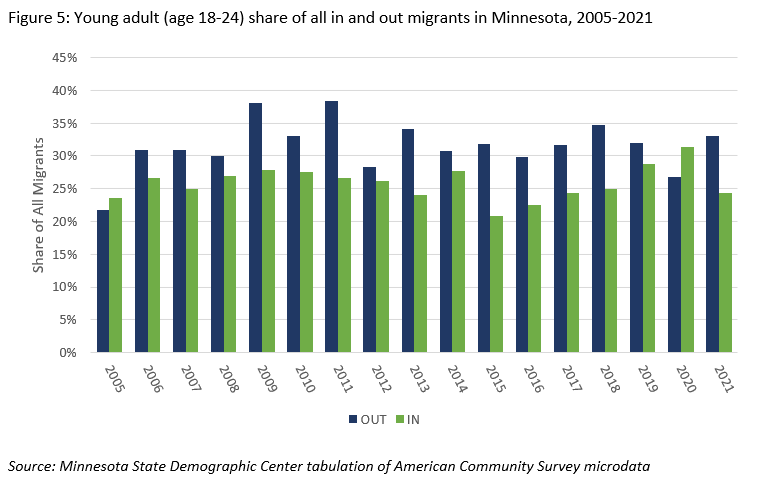
By 2021, in-migration dipped to 27,000, and out-migration swelled to 44,600, indicating a net loss. It is worth noting that the 2021 figures could be significantly influenced by the COVID-19 pandemic, affecting both the motives for and the logistics of moving. There have been oscillations throughout these years, with some years, like 2014, seeing a remarkable rise in in-migration and others, like 2015, experiencing a drop. Such variations often align with broader societal, economic, and educational trends. For instance, the availability of job opportunities, the reputation of educational institutions, housing affordability, and even broader economic or cultural shifts can play a role in determining these numbers.
While the consistent mobility observed in this age group underscores the importance of understanding their motivations, aspirations, and challenges, it's worth noting that our current data sets do not provide sufficient insight into these factors. Future research could offer a more comprehensive understanding that could guide policy and planning. In doing so, Minnesota can strategically position itself to attract and retain this demographic, ensuring a dynamic, youthful, and forward-looking population that contributes actively to the state's present and future.
The income distribution of individuals working full-time, year-round (FTYR) and migrating to Minnesota when surveyed between 2017 and 2021 offers intriguing contrasts to those who remained in the state. According to the ACS microdata, FTYR workers who recently moved to Minnesota appear to have a different income profile than those who stayed within the state.
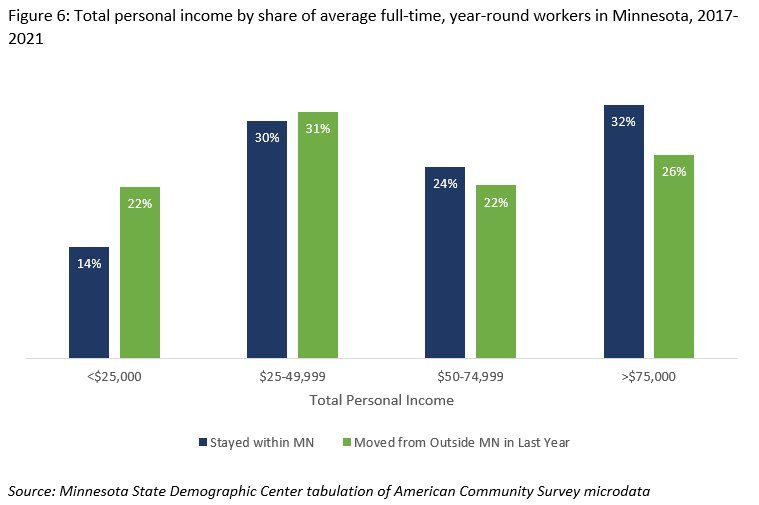
While 32% of FTYR workers who stayed in Minnesota earn more than $75,000 annually, this figure drops to 26% among recent in-migrants. Similarly, the under $25,000 income bracket is more substantially represented among newcomers, accounting for 22% compared to 14% among those who remained in-state. The middle-income categories ($25,000-$49,999 and $50,000-$74,999) show more comparable distributions between the two groups.
This data suggests Minnesota draws in diverse FTYR workers, each with unique economic contributions and needs. New arrivals are more likely to fall into the lower or middle-income brackets, potentially indicating early-career or transitional phases. On the other hand, those who have established themselves in Minnesota tend to fall into higher income categories. Such income diversity among in-migrants has implications for various sectors in Minnesota, from housing to public services, and adds a layer of complexity to the state's economic landscape.
In analyzing the educational backgrounds of migrants aged 25 and over in Minnesota, the data reveals nuanced patterns that offer valuable insights into the state's shifting socio-economic dynamics. For a more detailed understanding, we have categorized the data into three primary groups: 1) individuals who either did not move or moved within Minnesota, 2) those who moved to Minnesota in the last year from another state, and 3) those who moved to Minnesota in the last year from abroad.
For individuals with a high school diploma or less, 31% have opted to either stay in their current homes or move elsewhere within Minnesota. In contrast, 23% in this educational category moved to Minnesota from another state, while a surprising 31% moved from abroad. Based on these findings, domestic in-migrants and international immigrants moving to Minnesota have higher average educational attainment than those not moving within the state. Minnesota is an attractive destination for highly educated individuals from within the U.S. and abroad. Such trends could indicate the presence of opportunities for high-skilled jobs, academic endeavors, or other factors drawing educated populations to the state.
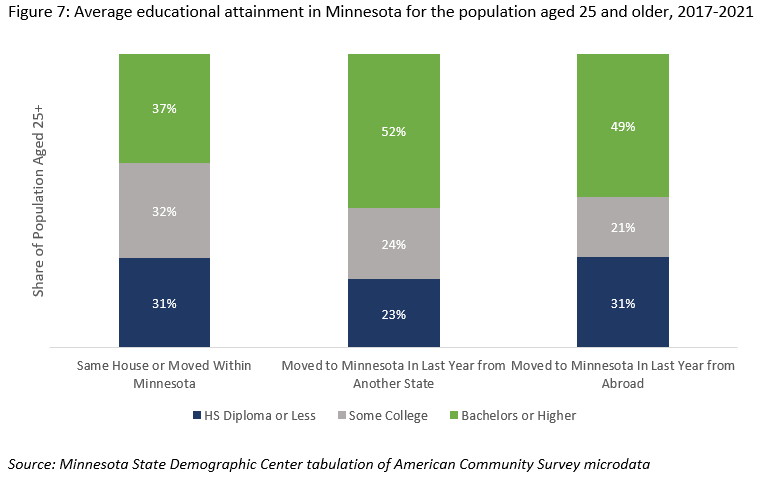
Regarding those with some college education, 32% chose to remain or move within the state, 24% relocated to Minnesota from another state, and 21% moved abroad. These percentages are like those of the high school diploma or less group, implying that similar factors may influence both categories to stay within or move to Minnesota.
The data offers compelling insights when examining individuals with a bachelor's degree or higher. Of this educated cohort, 37% have remained or moved within Minnesota. However, a larger share—52 percent—transferred to the state from another state in the U.S., and 49% arrived from abroad. These figures highlight that Minnesota attracts a significantly more educated migrant population than its existing residents, both domestically and internationally. The younger age profile of these migrants further suggests that the state is not just drawing intellectual capital but also youthful vibrancy, which could have long-term socio-economic implications.
While we cannot assert causation, the data shows correlations between educational levels and distinct migration choices. These patterns could be crucial for future workforce development, educational policy planning, and community-based initiatives aimed at either retaining or attracting diverse educational demographics. As Minnesota continues to evolve, understanding these educational and migratory patterns becomes essential for making informed decisions that will shape its economic and social future.
Migration is an evolving phenomenon shaped by many factors ranging from global events to individual preferences. As Minnesota looks to the future, several emerging migration trends, influenced by broader global developments, could have profound implications for our demography and economy.
Urban Pull – The allure of urban centers, a trend mirrored worldwide, is expected to continue to play a significant role in Minnesota's demographic landscape. Urban areas are powerful magnets with their eclectic mix of job opportunities, cultural amenities, and social infrastructure. As more people gravitate toward these centers, Minnesota's cities might witness increased population densities. While urbanization can stimulate economic dynamism and cultural vibrancy, it also presents challenges. Housing demand, infrastructure strain, and evolving service requirements could be pressing concerns. Planning for sustainable urban growth will be paramount to ensure that cities remain livable and retain their appeal.
Climate As a Catalyst – Another emerging factor in migration patterns is the escalating impact of climate change. As regions increasingly experience environmental catastrophes and resource scarcity, areas like Minnesota, with its relatively stable climate and abundant water resources, could become more appealing as safe havens. These resources position the state not only as a desirable destination but also as a potential site for emergency management and refugee resettlement in the face of climate-induced displacement. While an influx of migrants under such circumstances could enrich the local talent pool and stimulate the economy, it simultaneously poses challenges. These include resource management, housing, infrastructure, and the complex logistics of climate refugee resettlement. Sustainable policies will be essential for accommodating and integrating new residents without compromising Minnesota's ecological balance or overwhelming existing systems.
Decoupling Work from Location – One of the most transformative shifts in recent times has been the rise of remote work. The pandemic catalyzed a move from traditional office-centric roles, ushering in an era where workers and employers increasingly decoupled work from location. This change presents an unprecedented opportunity for states like Minnesota, known for our high quality of life, scenic beauty, and community-centric living. Individuals can now reside in Minnesota, drawing on the lifestyle benefits, while working for organizations headquartered in distant cities or countries. This trend could result in a more diverse population, increased demand for residential properties, and a shift in local economies toward sectors supporting remote work, like IT infrastructure and digital services.
The ebb and flow of people in and out of Minnesota provide a complex but invaluable lens through which to examine the state's evolving demographic, economic, and social landscape. This research article has presented a detailed exploration of various dimensions of migration, covering domestic and international inflows and outflows, education levels, income brackets, and regional interconnections to offer a nuanced understanding of the multiple forces shaping Minnesota today.
In terms of income and educational attainment, clear patterns have emerged that provide insights into Minnesota's opportunities and challenges. For instance, the state seems particularly attractive to individuals with higher levels of education, presenting a chance to capitalize on a skilled and diverse workforce. However, understanding the specific needs and aspirations of various income and education groups can help fine-tune policies to retain or attract these demographics more effectively.
Regional trends within the U.S. and internationally present a compelling narrative of Minnesota's place in broader migration patterns. The state's interaction with specific regions and countries underscores its magnetic appeal and enriches its cultural tapestry, offering the potential for strengthened global partnerships.
Understanding this complex migration landscape is not abstract but imperative for shaping future policy. The trends and patterns revealed in this article offer a foundation upon which Minnesota can build strategic responses—whether to further capitalize on its strengths or to address its weaknesses. As Minnesota stands on the cusp of significant demographic and economic shifts, informed, forward-thinking planning and policy interventions will determine its role in the broader U.S. and global migration narratives. By doing so, the state has the potential to forge a future that is not only prosperous but also inclusive and diverse.